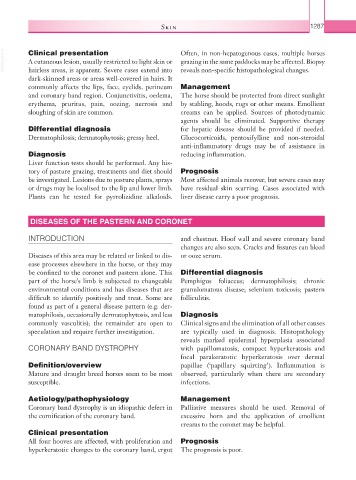Page 1312 - Equine Clinical Medicine, Surgery and Reproduction, 2nd Edition
P. 1312
Skin 1287
VetBooks.ir Clinical presentation Often, in non-hepatogenous cases, multiple horses
grazing in the same paddocks may be affected. Biopsy
A cutaneous lesion, usually restricted to light skin or
hairless areas, is apparent. Severe cases extend into
dark-skinned areas or areas well-covered in hairs. It reveals non-specific histopathological changes.
commonly affects the lips, face, eyelids, perineum Management
and coronary band region. Conjunctivitis, oedema, The horse should be protected from direct sunlight
erythema, pruritus, pain, oozing, necrosis and by stabling, hoods, rugs or other means. Emollient
sloughing of skin are common. creams can be applied. Sources of photodynamic
agents should be eliminated. Supportive therapy
Differential diagnosis for hepatic disease should be provided if needed.
Dermatophilosis; dermatophytosis; greasy heel. Glucocorticoids, pentoxifylline and non-steroidal
anti-inflammatory drugs may be of assistance in
Diagnosis reducing inflammation.
Liver function tests should be performed. Any his-
tory of pasture grazing, treatments and diet should Prognosis
be investigated. Lesions due to pasture plants, sprays Most affected animals recover, but severe cases may
or drugs may be localised to the lip and lower limb. have residual skin scarring. Cases associated with
Plants can be tested for pyrrolizidine alkaloids. liver disease carry a poor prognosis.
DISEASES OF THE PASTERN AND CORONET
INTRODUCTION and chestnut. Hoof wall and severe coronary band
changes are also seen. Cracks and fissures can bleed
Diseases of this area may be related or linked to dis- or ooze serum.
ease processes elsewhere in the horse, or they may
be confined to the coronet and pastern alone. This Differential diagnosis
part of the horse’s limb is subjected to changeable Pemphigus foliaceus; dermatophilosis; chronic
environmental conditions and has diseases that are granulomatous disease; selenium toxicosis; pastern
difficult to identify positively and treat. Some are folliculitis.
found as part of a general disease pattern (e.g. der-
matophilosis, occasionally dermatophytosis, and less Diagnosis
commonly vasculitis); the remainder are open to Clinical signs and the elimination of all other causes
speculation and require further investigation. are typically used in diagnosis. Histopathology
reveals marked epidermal hyperplasia associated
CORONARY BAND DYSTROPHY with papillomatosis, compact hyperkeratosis and
focal parakeratotic hyperkeratosis over dermal
Definition/overview papillae (‘papillary squirting’). Inflammation is
Mature and draught breed horses seem to be most observed, particularly when there are secondary
susceptible. infections.
Aetiology/pathophysiology Management
Coronary band dystrophy is an idiopathic defect in Palliative measures should be used. Removal of
the cornification of the coronary band. excessive horn and the application of emollient
creams to the coronet may be helpful.
Clinical presentation
All four hooves are affected, with proliferation and Prognosis
hyperkeratotic changes to the coronary band, ergot The prognosis is poor.

